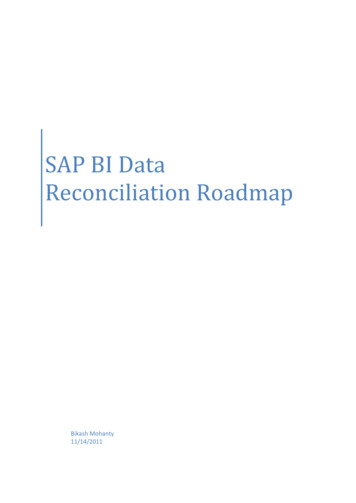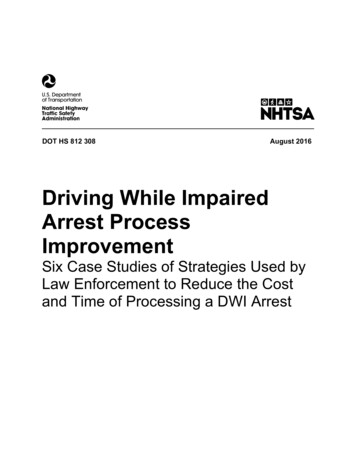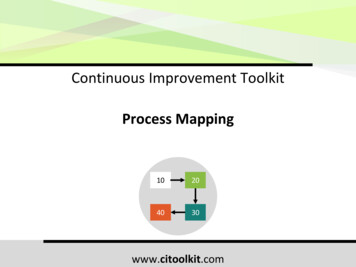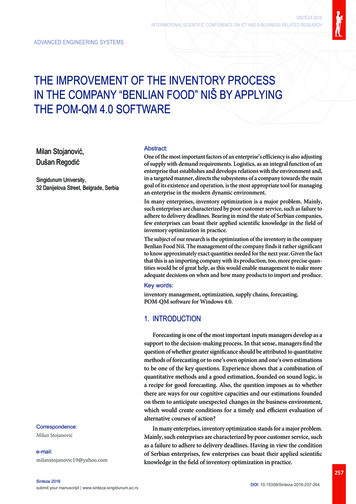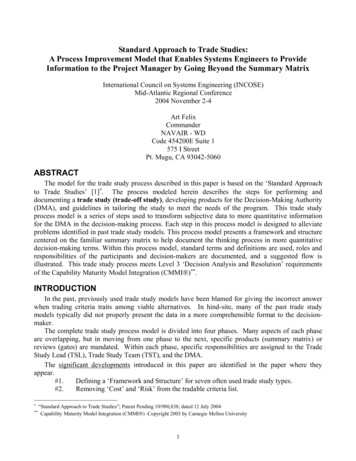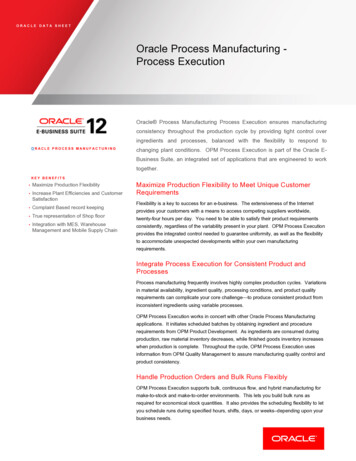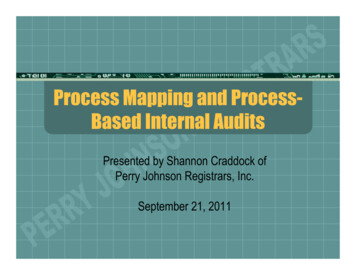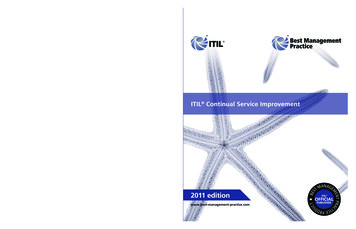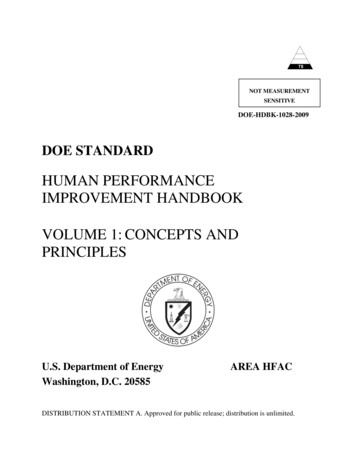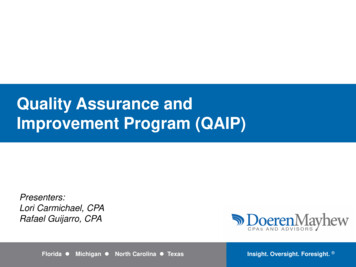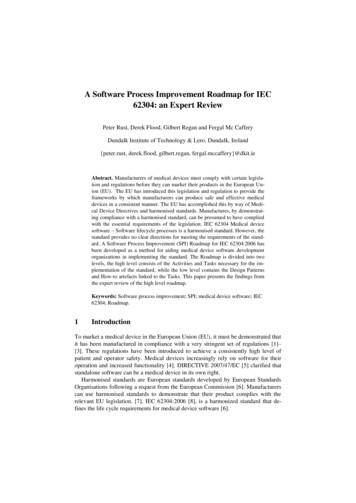
Transcription
A Software Process Improvement Roadmap for IEC62304: an Expert ReviewPeter Rust, Derek Flood, Gilbert Regan and Fergal Mc CafferyDundalk Institute of Technology & Lero, Dundalk, Ireland{peter.rust, derek.flood, gilbert.regan, fergal.mccaffery}@dkit.ieAbstract. Manufacturers of medical devices must comply with certain legislation and regulations before they can market their products in the European Union (EU). The EU has introduced this legislation and regulation to provide theframeworks by which manufacturers can produce safe and effective medicaldevices in a consistent manner. The EU has accomplished this by way of Medical Device Directives and harmonised standards. Manufactures, by demonstrating compliance with a harmonised standard, can be presumed to have compliedwith the essential requirements of the legislation. IEC 62304 Medical devicesoftware – Software lifecycle processes is a harmonised standard. However, thestandard provides no clear directions for meeting the requirements of the standard. A Software Process Improvement (SPI) Roadmap for IEC 62304:2006 hasbeen developed as a method for aiding medical device software developmentorganizations in implementing the standard. The Roadmap is divided into twolevels, the high level consists of the Activities and Tasks necessary for the implementation of the standard, while the low level contains the Design Patternsand How-to artefacts linked to the Tasks. This paper presents the findings fromthe expert review of the high level roadmap.Keywords: Software process improvement; SPI; medical device software; IEC62304; Roadmap.1IntroductionTo market a medical device in the European Union (EU), it must be demonstrated thatit has been manufactured in compliance with a very stringent set of regulations [1]–[3]. These regulations have been introduced to achieve a consistently high level ofpatient and operator safety. Medical devices increasingly rely on software for theiroperation and increased functionality [4]. DIRECTIVE 2007/47/EC [5] clarified thatstandalone software can be a medical device in its own right.Harmonised standards are European standards developed by European StandardsOrganisations following a request from the European Commission [6]. Manufacturerscan use harmonised standards to demonstrate that their product complies with therelevant EU legislation. [7]. IEC 62304:2006 [8], is a harmonized standard that defines the life cycle requirements for medical device software [6].
2The implementation of standards, such as IEC 62304, is challenging as the standard sets out the requirements that must be met but does not state how to meet them.The “how-to” element of standards implementation is difficult. Organisations implementing standards for the first time could engage specialist consultants to aid in theimplementation. Engaging consultants can be costly and Small to Medium Sized Enterprises (SME) can find the provision of these costs prohibitive.Roadmaps are ubiquitous in the technology domain. Since their inception in the1970’s, roadmaps have been developed for numerous other sectors. More than twothousand public-domain roadmaps, organised by topic, from over fourteen differentsectors have been identified and catalogued [9].The solution proposed here is a tailorable SPI Roadmap for the implementation ofIEC 62304. The Roadmap points to a series of “How-To” artefacts that the organisation may utilise to direct them on how-to complete certain tasks. The completion ofthese tasks allows the organisation to meet the requirements of the standard associatedwith the particular task. The definition of the SPI Roadmap in this research, based onFlood’s [10] definition with minor changes, is – “A series of Activities, comprised ofTasks that will guide an organisation through the use of specific “How-To’s” towardscompliance with regulatory standards.”The remainder of this paper is structured as follows: Section 2 outlines the relatedwork while Section 3 outlines the proposed solution. Section 4 outlines the researchmethod used to carry out the validation of the Roadmap. Section 5 presents the resultsof the expert review. Section 6 details the changes made to the Roadmap while Section 7 discusses the validity of the review. Section 8 outlines the future work to becarried out before Section 9 concludes the paper.2Related WorkOrganisations of all sizes find difficulty in the implementation of standards. Yahya &Goh [11] reported that organisations implementing ISO 9000 encountered barrierssuch as: lack of understanding of the standard; constraints on resources (manpower,time, finance); lack of training and education of employees and unclear benefits ofobtaining certification. As part of this research, a survey of four organisations operating in the Irish medical device software development domain was carried out to tryand identify the challenges faced by organisations implementing IEC 62304. All theorganisations reported that the sourcing and provision of training, incorporating traditional software development practices into an agile environment and adding new processes were among some of the challenges they faced. Additionally, the cost of implementing IEC 62304 was identified as a major challenge by 75% of the organisations surveyed. The understanding/interpretation of the requirements, sourcing template documents, production of the documentation required to demonstrate compliance, installation of a document management system, implementing overly complexprocesses and the rigorous planning that must be carried out at the start of the projectwere challenges that 25% of the respondents found difficult. Höss [12] reporting on
3the experience of implementing IEC 62304 in a radiotherapy unit stated that the “initial effort is significant and a learning curve must be overcome”, which can be costly.One solution to overcome the challenge posed by these costs could be the use ofRoadmaps. Road mapping is a process that has developed from its inception in the1970’s to an internationally accepted practice today. Bob Galvin the then CEO ofMotorola is credited with the development of the first technology roadmap [13].Roadmapping is used companywide by Motorola and they state that it is responsiblefor adding over two billion dollars of value to the company since the 1970’s [14].Technology roadmaps are accepted as the correct way of planning the way forward toachieve a desired goal by describing what has to be done to reach it [15]. The powerof a roadmap lies in its ability to clearly show the route that is planned [16]. Cooper &Edgett reported that 38% of the best performing businesses used product developmentroadmaps [17]. The provision of a guide on how to implement IEC 62304 would beone method of aiding medical device software development organisations in meetingthe challenges of implementing the standard.3Proposed SolutionThe proposed solution is an SPI Roadmap, detailed in Figure 1, consisting of twolevels, the high level contains the Activities and Tasks necessary for implementingIEC 62304 and the low level contains the Design Patterns and How-to artefacts thatguide the organisation in how-to complete the Tasks.Figure 1 Roadmap StructureThe high level Roadmap comprises sixteen Activities, grouped in four bands thatallow for their introduction to the organisation in a timely manner. The bands are: 1Foundational, 2-Production, 3-Post Production and 4-Change/Problem Management.It is important to note that the Roadmap is constructed using a spreadsheet. Thegraphic is included in one worksheet and each Activity has its own linked worksheetcontaining all the associated Tasks. The graphic for the SPI Roadmap developed aspart of this research is presented in Figure 2.
4Fig. 2. Roadmap Graphic before Expert ReviewThe Roadmap has been developed in accordance with well-established practice[18]. The aim of the expert review was to determine if the Activities and Tasks in thehigh level Roadmap are correct.4Research MethodThe research method consists of five stages as detailed in Figure 3.Fig. 3. Steps in Research Method1Develop the QuestionnaireThe design of the questionnaire was developed in line with Burgess’s findings [19].Three questions were developed to determine if the high level Roadmap contains allthe Activities necessary for the implementation of IEC 62304, if the order of the Activities is correct and if their grouping is appropriate. A further three questions weredeveloped to review each of the Activities, to determine if the Tasks are suitable forthe Activities, if their order within each Activity is correct and will the Tasks, oncecompleted, fulfil the objectives of each of the Activities. A Likert scale was used inassociation with each of the six questions to allow the reviewer to rate the answers tothe questions posed. One corresponded to “strongly disagree” and five with “stronglyagree”. A comment box was also included with each question to allow the expertexplain their answer in more detail if they wished.2Select the ExpertsExperts from the medical device standards community with specialized knowledge ofIEC 62304 were contacted and invited to participate in the review. These same ex-
5perts were also asked to nominate other experts with the same type of experience withmedical device standards. Six experts agreed to participate in the review.Expert 1 has eleven years working with the implementation of IEC 62304 and sixyears actively involved in developing the standard.Expert 2 has worked for over thirty years with a major international medical deviceand systems manufacturer, in positions ranging from project manager, through togroup manager. They have also served as a medical device software expert to the IECand ISO joint working groups developing the standard.Expert 3 has twenty six years’ experience in medical device software, sixteen ofwhich as an active member of the ISO/IEC working group responsible for the development of IEC 62304.Expert 4 Commenced as a software developer for IVD devices complying withIEC 62304, progressing to project manager for similar devices. Through their ownconsultancy firm they advise organisations on the implementation of IEC 62304.Expert 5 has over twenty years’ experience in medical device software development and worked on the development of IEC 62304:2006.Expert 6 has thirty five years developing hardware and software for medical devices. They are also a co-chair of the 2nd Edition of IEC 62304.3 Conduct the ReviewThe experts were forwarded a copy of the spreadsheet containing the high levelRoadmap together with the questionnaires. The first two Activities refer directly toother standards, the quality and risk management systems, each consisting of singletasks. For this reason the experts were not asked questions about these Tasks. Questions on whether the Roadmap included all of the Activities necessary, the order ofthe Activities and their grouping within the Roadmap constituted the first questionnaire. Their answers were recorded on a five level Likert scale. The experts could addadditional explanation of their answers or comments in the box provided. The secondquestionnaire included questions on the Tasks contained in each Activity: are theysuitable for the Activity, are they in an appropriate order and are they complete. Acomment box as described above was also included.4 Analyse the ResultsTwo methods are utilized to analyse the results. Firstly the mean and standard deviation are calculated for the answers to each question and secondly the comments madewere manually analysed using a content analysis approach.5 Conduct Focus Group and Revise RoadmapFollowing the analysis, a focus group consisting of three experts with experience ofmedical device software development, roadmaps and software process improvementfrom the Regulated Software Research Centre based in Dundalk Institute of Technology, Ireland, was convened to consider the results of the expert review. The sessionswere arranged as described by Tremblay et al [20]. The results of the Likert scaleanswers and the expert’s comments were tabulated along with the Activities andTasks that they referenced. The focus group discussed each comment and a consensuswas reached as to whether or not a change was required.
65Results5.1The RoadmapThe mean and standard deviation (SD) were calculated for the results recorded foreach question. It was found that all of the Activities that are necessary (mean 4.6, SD0.5) for the implementation of IEC 62304 are included and that the grouping of theActivities (mean 4.0, SD 1.1) is appropriate. There is no strong feeling as to whetherthe order of the Activities (mean 3.0, SD 0.6) is correct.The content analysis of the comments on the Roadmap resulted in the creation offour categories:1.2.3.4.Structural: Comments concerned with the graphical representation of theRoadmap.Regrouping of Activities: Comments with regard to the placement of the Activities within the individual bands comprising the Roadmap.Timing of Activities: Comments about the timeline by which the Activities areintroduced to the organisation.Definition of Terms used in Roadmap: Comments referencing certain termsused in the Roadmap and where confusion might occur due to their use in thecontext of a medical device software improvement roadmap.Structural: This category attracted two comments. The main concern was that thegraphical representation of the roadmap implied that agile methods were not an option. To address this issue, more emphasis is being placed on the fact that theRoadmap is not a program but rather a timeline by which the Activities are introducedto the organisation. The objective of the Roadmap is to aid the implementation of thestandard. It is important to note that similar to IEC 62304, the Roadmap does notprescribe any particular life cycle model. The focus group concluded that the “bars”in band 2, the production block, should be widened to emphasize that agile methodsare
IEC 62304, progressing to project manager for similar devices. Through their own consultancy firm they advise organisations on the implementation of IEC 62304. Expert 5 has over twenty years’ experience in medical device software develop-ment and worked on the development of IEC 62304:2006. Expert 6 has thirty five years developing hardware and software for medical devic- es. They are also a .
